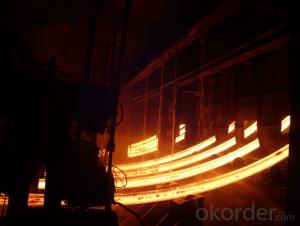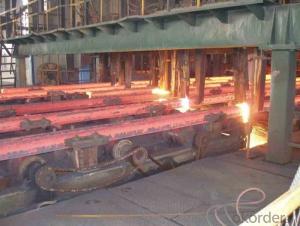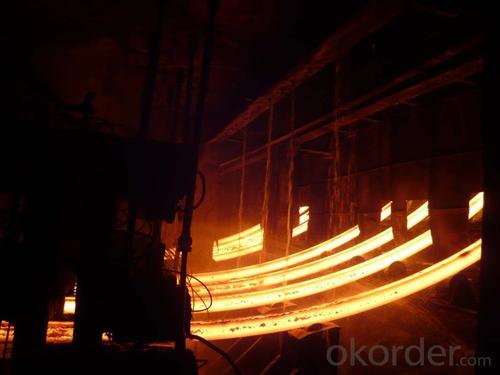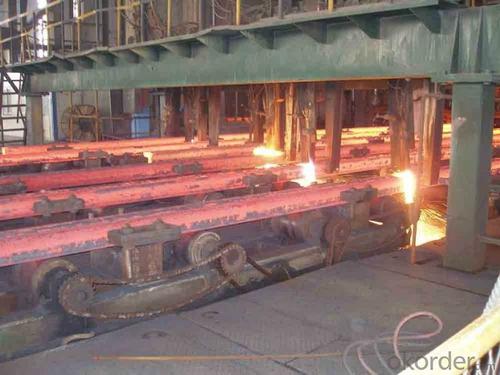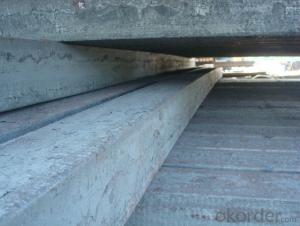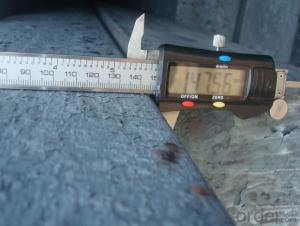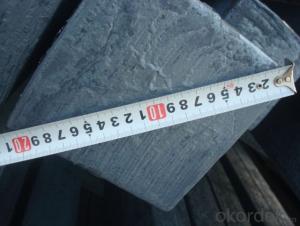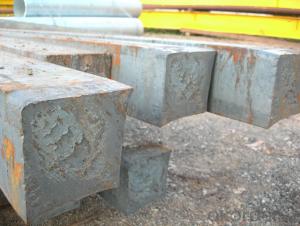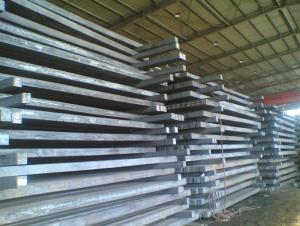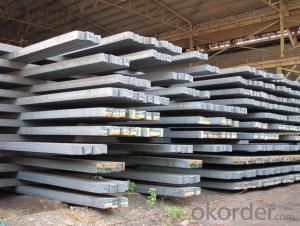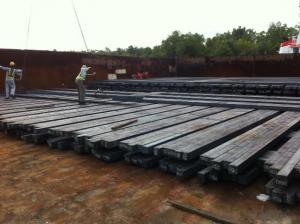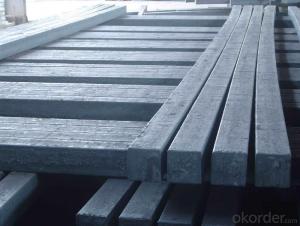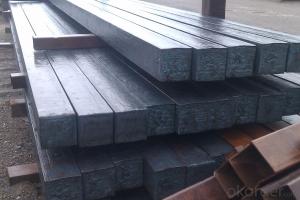Prime square alloy steel billet 175mm Q235
- Loading Port:
- Shanghai
- Payment Terms:
- TT OR LC
- Min Order Qty:
- 100 m.t.
- Supply Capability:
- 10000 m.t./month
OKorder Service Pledge
OKorder Financial Service
You Might Also Like
Structure of Prime square alloy steel billet 175mm Q235
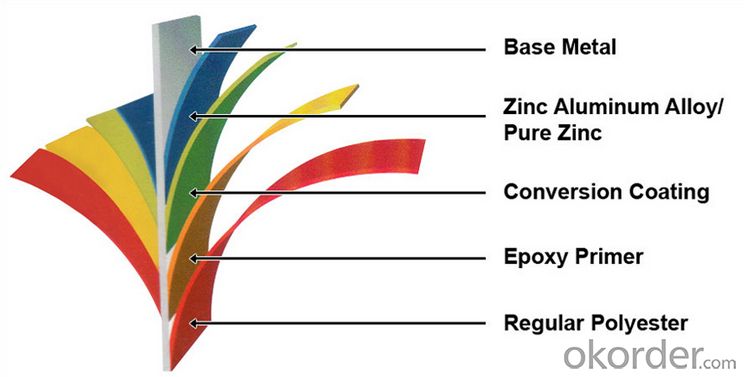
Description of Prime square alloy steel billet 175mm Q235
1) Excellent corrosion resistance: The zinc layer provides a good protection of Pre-painted Galvanizeed Steel Sheet.
2) High heat resistance: The reflective surface of the material aids in efficiently reflecting the sunlight away and in turn reducing the amount of heat transmitted. The thermal reflectivity converts into energy savings.
3) Aesthetics: Pre-Painted Galvanized steel sheet is available in plethora of patterns and multiple sizes as per the requirements that given by our customers.
4) Versatility: can be used in the various areas.
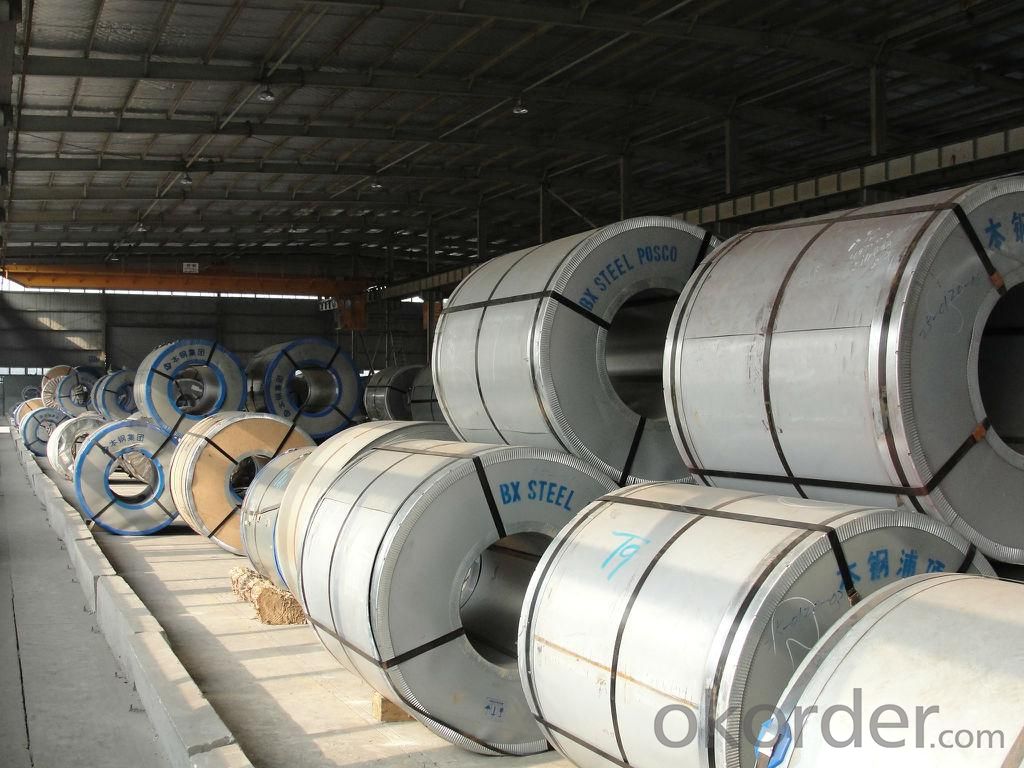
Main Feature of Prime square alloy steel billet 175mm Q235
Uncoated CR steel sheet
With the features of in line with the international highest standards in demension and shape, excellent surface finish and properties, the products are mainly used in home appliance and automobile industries.
Galvanized steel sheet(include HDG and EG)
With the features of good corrosion resistance, the products are mainly used in automobile, home appliance, electronics, building and machinery manufacture industries, etc.
Precoated steel sheet
With the features of enviromental protection and good processablility, long lasting surface durability, rich in colors, the products are maily used in building, home appliance and furniture industries, etc.
Applications of Prime square alloy steel billet 175mm Q235
1) Excellent corrosion resistance: The zinc layer provides a good protection of Pre-painted Galvanizeed Steel Sheet.
2) High heat resistance: The reflective surface of the material aids in efficiently reflecting the sunlight away and in turn reducing the amount of heat transmitted. The thermal reflectivity converts into energy savings.
3) Aesthetics: Pre-Painted Galvanized steel sheet is available in plethora of patterns and multiple sizes as per the requirements that given by our customers.
4) Versatility: can be used in the various areas.
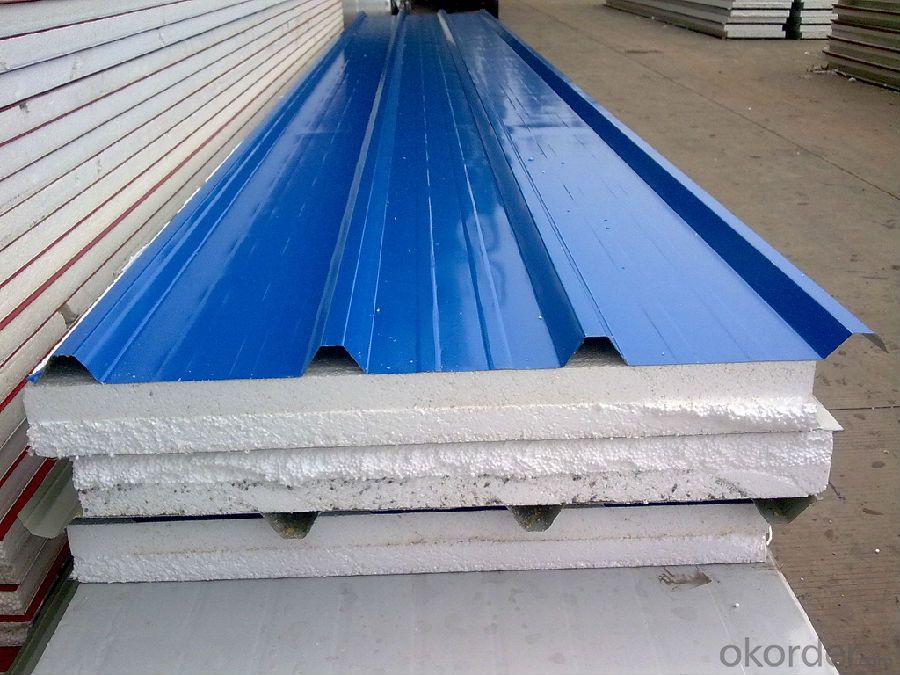
Specifications of Prime square alloy steel billet 175mm Q235
Product | Billet |
Material Grade | SGCC / SGCH / DX51D+AZ, etc |
Thickness | 0.6-3.0mm |
Width | 500-1500mm |
Tolerance | Thickness: +/-0.02mm , Width:+/-2mm |
Zinc-coating | Z30-150g/m2 |
Technique | Raw material: Hot rolled steel coil --> Cold rolled_>hot dipped galvalume |
Surface | Dried, Chromated, Unoiled |
Spangle | Regular spangle , small spangle, zero spangle |
ID | 508MM 610MM |
Coil weight | 1-25MT |
Export package | Cardboard inner sleeves, Waterproof paper, galvanized steel covered and steel strip packed |
FAQ of Prime square alloy steel billet 175mm Q235
We have organized several common questions for our clients,may help you sincerely:
1. How Can I Visit There?
Our company is located in Tianjin City, China, near Beijing. You can fly to Tianjin Airport Directly. All our clients, from home or aboard, are warmly welcome to visit us!
2. How Can I Get Some Sample?
We are honored to offer you sample.
3. Why choose CNBM?
we always fix steel produce in container well to make it safe arrive at destination port
we always provide best and professional forward service for our buyer
we always apply 14days free detention for our buyers container in destination
we provide one set After-sales service for our buyer
we provide China inland steel market price report
we help our buyer become number one in local market .
- Q: How are steel billets used in the manufacturing of forgings?
- Steel billets are used in the manufacturing of forgings as they serve as the initial raw material. These billets are heated and then shaped using a variety of forging techniques such as hammering or pressing, resulting in the desired forged product. The high strength and malleability of steel make it an ideal material for forgings used in various industries, including automotive, aerospace, and construction.
- Q: How are steel billets heated for rolling?
- To prepare steel billets for rolling, they undergo a process known as billet heating or billet reheating. This involves subjecting the billets to high temperatures, making them more malleable and easier to shape during rolling. Various methods can be used to heat steel billets for rolling. One commonly employed technique involves the utilization of a walking beam furnace. Here, the billets are positioned on a conveyor that moves them through a furnace. The furnace is heated to a specific temperature, typically ranging from 1100 to 1250 degrees Celsius, and the billets are exposed to this heat for a predetermined duration. Continuously moving the billets through the furnace ensures uniform heating. Another method for billet heating involves the use of a rotary hearth furnace. In this approach, the billets are placed on a rotating hearth, which is heated by burners located beneath it. As the billets rotate on the hearth, they gradually absorb the heat emitted by the burners, gradually reaching the desired temperature. Induction heating is also a popular option for billet heating. This method employs an induction coil to generate an alternating magnetic field. The billets are placed within the coil, and the magnetic field induces electrical currents within them, resulting in the billets heating up. Induction heating is renowned for its efficiency and precise temperature control. Once the steel billets attain the desired temperature, they are ready for the rolling process. The heated billets are then transferred to a rolling mill, where they undergo further processing and shaping into various forms, such as bars, rods, or sheets. The heating process is crucial, as it enhances the ductility of the steel billets, minimizing the risk of cracking or failure during rolling.
- Q: What are the different types of surface finishes available for steel billets?
- There are several different types of surface finishes available for steel billets, each serving a specific purpose and offering unique characteristics. Some of the most common surface finishes for steel billets include: 1. Hot Rolled: This is the most basic surface finish, achieved by heating the steel billet above its recrystallization temperature and then rolling it to the desired shape and size. Hot rolled steel billets have a rough and scaled surface, which is suitable for applications where aesthetics are not a primary concern. 2. Cold Rolled: This surface finish is obtained by further processing the hot rolled billets through a series of cold rolling processes. Cold rolled steel billets have a smoother and more refined surface, with tighter tolerances and improved dimensional accuracy. 3. Pickled and Oiled: This surface finish involves removing any rust, scale, or mill scale from the steel billets by immersing them in an acidic solution, commonly known as pickling. After pickling, the steel billets are oiled to provide temporary corrosion protection. This finish is ideal for applications where cleanliness and corrosion resistance are crucial. 4. Galvanized: Galvanizing is a surface finishing process that involves coating the steel billets with a layer of zinc to provide enhanced corrosion resistance. This finish is particularly suitable for outdoor applications or environments with high humidity, where the steel needs protection against rust and corrosion. 5. Electroplated: Electroplating is a process where a thin layer of metal, such as nickel or chromium, is deposited onto the steel billets through an electrochemical reaction. This surface finish provides improved aesthetics, enhanced corrosion resistance, and can also offer specific functional properties, such as hardness or wear resistance. 6. Powder Coated: Powder coating is a surface finishing technique where a dry powder is electrostatically applied to the steel billets and then cured under heat to form a durable and protective coating. This finish offers excellent corrosion resistance, impact resistance, and a wide range of color options, making it popular in architectural and decorative applications. 7. Anodized: Anodizing is a surface treatment commonly used for aluminum, but it can also be applied to steel billets. This process involves creating an oxide layer on the surface of the steel by subjecting it to an electrolytic process. Anodized steel billets exhibit improved corrosion resistance, increased hardness, and can be dyed in various colors for aesthetic purposes. These are just a few examples of the different types of surface finishes available for steel billets. The choice of finish depends on the specific requirements of the application, including aesthetics, corrosion resistance, durability, and functional properties.
- Q: What are the different methods of steel billet surface polishing?
- There are several methods available for steel billet surface polishing, each with its own advantages and applications. These methods include mechanical polishing, chemical polishing, electrochemical polishing, and abrasive blasting. Mechanical polishing is a widely used method that involves the use of abrasive materials to remove surface imperfections and create a smooth finish. This can be done manually using sandpaper or with the help of machinery such as buffing machines or belt sanders. Mechanical polishing is effective in removing scratches, oxidation, and other surface defects, resulting in a polished and reflective surface. Chemical polishing is a non-mechanical method that utilizes chemical reactions to remove surface imperfections. This process involves the immersion of the steel billet in a chemical solution that dissolves a thin layer of the material, resulting in a smoother surface. Chemical polishing is often used for intricate or delicate parts, as it can achieve a high level of precision and uniformity. Electrochemical polishing, also known as electropolishing, is a method that combines chemical and electrical processes to polish the steel billet surface. It involves immersing the billet in an electrolyte solution and applying an electric current. The electrical current removes microscopic peaks and imperfections, resulting in a smoother and brighter surface. Electrochemical polishing is commonly used for stainless steel billets due to its ability to remove surface contaminants and enhance corrosion resistance. Abrasive blasting, also known as sandblasting, is a method that uses high-pressure air or water to propel abrasive materials onto the steel billet surface. This process effectively removes rust, scale, and other surface contaminants, resulting in a clean and textured finish. Abrasive blasting can be done using various abrasive materials such as sand, steel shot, or glass beads, depending on the desired surface finish. In summary, the different methods of steel billet surface polishing include mechanical polishing, chemical polishing, electrochemical polishing, and abrasive blasting. Each method has its own advantages and applications, offering a range of options to achieve the desired surface finish for steel billets.
- Q: How are steel billets forged into shape?
- Steel billets are forged into shape through a process called hot forging, which involves heating the billet to a specific temperature and then applying pressure to shape it using a forging press or hammer. This process helps to refine the grain structure of the steel, improving its strength and mechanical properties.
- Q: How are steel billets transported internationally?
- Steel billets can be transported internationally through various means such as shipping containers, bulk carriers, or by rail and road transport. The choice of transportation method depends on factors like distance, cost, volume, and urgency of delivery.
- Q: What are the main challenges in the supply chain management of steel billets?
- Supply chain management of steel billets presents several key challenges. These challenges encompass demand fluctuations, transportation and logistics, supply chain visibility, quality control, and sustainability concerns. Firstly, demand fluctuations pose a significant obstacle due to the steel industry's susceptibility to economic cycles and shifts in global demand. These fluctuations often result in imbalances within the supply chain, leading to excessive inventory or shortages of steel billets. Consequently, accurately forecasting demand and optimizing production and inventory levels becomes a challenging task for supply chain managers. Secondly, transportation and logistics prove to be major hurdles in the management of steel billets. The heavy and bulky nature of these billets necessitates the establishment of efficient transportation networks to ensure timely delivery. Moreover, the handling and storage of steel billets require specialized equipment and facilities, adding complexity and cost to the supply chain. Thirdly, supply chain visibility is crucial for mitigating inefficiencies and delays. Supply chain managers must have real-time information regarding inventory levels, production status, and transportation schedules. This enables them to make informed decisions and address any potential disruptions promptly. Next, quality control plays a vital role in maintaining consistent billet quality throughout the supply chain. Since steel billets are often produced by different manufacturers, variations in quality can arise. Consequently, supply chain managers need to implement robust quality control processes, including regular inspections, testing, and adherence to industry standards, to ensure the delivery of high-quality billets to customers. Finally, sustainability and environmental concerns add another layer of complexity to the supply chain management of steel billets. The steel industry faces mounting pressure to reduce its carbon footprint and adopt sustainable practices. As a result, supply chain managers must navigate the challenge of implementing environmentally friendly processes and sourcing billets from suppliers that adhere to sustainable practices. This involves evaluating the environmental impact of transportation methods, optimizing energy consumption during production, and ensuring responsible sourcing of raw materials. In summary, effectively managing the supply chain of steel billets requires addressing challenges related to demand fluctuations, transportation and logistics, supply chain visibility, quality control, and sustainability concerns. Overcoming these obstacles necessitates effective planning, collaboration with suppliers and customers, and the utilization of advanced technologies to enhance visibility and optimize processes.
- Q: How are steel billets used in the production of construction components?
- Steel billets are an intermediate product used in the production of construction components. They are typically heated and then shaped into various forms such as beams, columns, or rods, which are essential for constructing buildings, bridges, and other structures.
- Q: What are the different types of machining processes used for shaping steel billets?
- There are several types of machining processes used for shaping steel billets, including turning, milling, drilling, and grinding. Turning involves rotating the billet against a cutting tool to remove excess material and create a desired shape. Milling uses rotary cutters to remove material from the billet, while drilling creates holes using a rotating cutting tool. Grinding involves using an abrasive wheel to remove material and achieve a smooth surface finish. These processes can be performed individually or in combination to achieve the desired shape and dimensions of the steel billet.
- Q: What is the difference between a steel billet and a steel bar?
- A steel billet is a semi-finished product that is typically square or rectangular in shape and has a larger cross-sectional area compared to a steel bar. It is produced through the casting or rolling process and serves as raw material for further processing. On the other hand, a steel bar is a fully finished product that is typically round, hexagonal, or square in shape and has a smaller cross-sectional area. It is obtained by hot or cold working the steel billet through processes like rolling or drawing.
Send your message to us
Prime square alloy steel billet 175mm Q235
- Loading Port:
- Shanghai
- Payment Terms:
- TT OR LC
- Min Order Qty:
- 100 m.t.
- Supply Capability:
- 10000 m.t./month
OKorder Service Pledge
OKorder Financial Service
Similar products
Hot products
Hot Searches
Related keywords
